Tamu biology 111 - Study guides, Class notes & Summaries
Looking for the best study guides, study notes and summaries about Tamu biology 111? On this page you'll find 62 study documents about Tamu biology 111.
All 62 results
Sort by
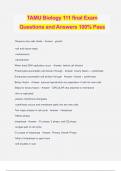
-
TAMU Biology 111 final Exam Questions and Answers 100% Pass
- Exam (elaborations) • 12 pages • 2024
- Available in package deal
-
- $12.49
- + learn more
TAMU Biology 111 final Exam Questions and Answers 100% Pass Reasons why cells divide - Answer- -growth -cell and tissue repair -maintenance -reproduction When does DNA replication occur - Answer- before cell division Prokaryotes accomplish cell division through - Answer- binary fission + cytokinesis Eukaryotes accomplish cell division through - Answer- mitosis + cytokinesis Binary fission - Answer- asexual reproduction by separation of cell into new cells Steps for binary fission - Ans...
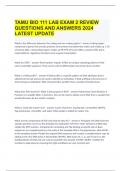
-
TAMU BIO 111 LAB, MGMT 209 and BIOLOGY 111 EXAMINATIONS WITH ANSWERS
- Package deal • 15 items • 2024
-
- $26.99
- + learn more
BIOLOGY 111 LAB PRACTICAL 2 TAMU EXAM QUESTIONS AND ANSWERS 2024 TAMU BIOL 111 LAB PRACTICAL: EXERCISE 7-12 WITH VERIFIED CORRECT ANSWERS BIO 111 LAB TAMU EXAM 1 WITH VERIFIED CORRECT ANSWERS 2024 TEXAS A&M BIOLOGY 111 PRACTICAL EXAM PREP EXAM QUESTIONS AND ANSWERS 2024 MGMT 209 FINAL STUDY GUIDE QUESTIONS (TAMU SWIM)
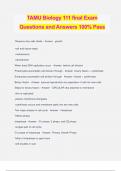
-
TAMU Biology 111 final Exam Questions and Answers 100% Pass
- Exam (elaborations) • 12 pages • 2024
- Available in package deal
-
- $12.49
- + learn more
TAMU Biology 111 final Exam Questions and Answers 100% Pass Reasons why cells divide - Answer- -growth -cell and tissue repair -maintenance -reproduction When does DNA replication occur - Answer- before cell division Prokaryotes accomplish cell division through - Answer- binary fission + cytokinesis Eukaryotes accomplish cell division through - Answer- mitosis + cytokinesis Binary fission - Answer- asexual reproduction by separation of cell into new cells Steps for binary fission - Ans...

-
TAMU BIOLOGY 111 TOP Selected Questions and Verified Answers
- Exam (elaborations) • 15 pages • 2024
-
- $7.99
- + learn more
functional group - components of a biochemical molecule, identifies the type of biomolecule hydroxyl group - a functional group found in alcohols and sugars, polar, OH carbonyl group - found in carbohydrates, two types terminal aldehyde and an internal ketone one or the other on every monosaccharide carboxyl - found in fatty acids and amino acids, acidic, double bond between carbon and oxygen and a single bond between carbon to hydroxyl, CO2H or COOH Amino group - In every amino acid,...
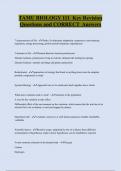
-
TAMU BIOLOGY 111 Key Revision Questions and CORRECT Answers
- Exam (elaborations) • 15 pages • 2024
-
- $7.99
- + learn more
7 characteristics of life - Order, Evolutionary adaptation, responses to environment, regulation, energy processing, growth and development, reproduction 3 domains of life - Domain Bacteria- bacteria prokaryotes Domain Archaea- prokaryotes living in extreme climates like boiling hot springs Domain Eukarya- animals and fungi and plants and protists Reductionist - Approaches to biology that break everything down into the simplest possible components to study Systems Biology - Approach tri...

-
TAMU BIOLOGY 111 Top Projected Questions and CORRECT Answers
- Exam (elaborations) • 12 pages • 2024
-
- $7.99
- + learn more
Reasons why cells divide - -growth -cell and tissue repair -maintenance -reproduction When does DNA replication occur - before cell division Prokaryotes accomplish cell division through - binary fission + cytokinesis Eukaryotes accomplish cell division through - mitosis + cytokinesis Binary fission - asexual reproduction by separation of cell into new cells Steps for binary fission - -CIRCULAR dna attaches to membrane -dna is replicated
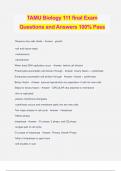
-
TAMU Biology 111 final Exam Questions and Answers 100% Pass
- Exam (elaborations) • 12 pages • 2024
-
- $12.49
- + learn more
TAMU Biology 111 final Exam Questions and Answers 100% Pass Reasons why cells divide - Answer- -growth -cell and tissue repair -maintenance -reproduction When does DNA replication occur - Answer- before cell division Prokaryotes accomplish cell division through - Answer- binary fission + cytokinesis Eukaryotes accomplish cell division through - Answer- mitosis + cytokinesis Binary fission - Answer- asexual reproduction by separation of cell into new cells Steps for binary fission - Ans...

-
TAMU BIOLOGY 111 Top Questions and CORRECT Answers
- Exam (elaborations) • 10 pages • 2024
-
- $7.99
- + learn more
Domain Archaea - Prokaryotic, single-celled organisms; have cell walls; reproduce using binary fission (duplication); RNA sequence is most similar to Eukarya; live in extreme environments and therefore do not infect humans; oldest life forms; include methanogens, extreme thermophiles, and extreme halophiles. Domain Bacteria - Prokaryotic, single-celled organisms; have cell walls; reproduce using binary fission; differ from archaea in environment and materials in cell wall; includes cy...
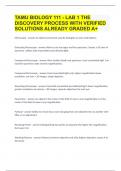
-
TAMU BIOLOGY 111 - LAB 1 THE DISCOVERY PROCESS WITH VERIFIED SOLUTIONS ALREADY GRADED A+
- Exam (elaborations) • 3 pages • 2023
- Available in package deal
-
- $15.99
- + learn more
TAMU BIOLOGY 111 - LAB 1 THE DISCOVERY PROCESS WITH VERIFIED SOLUTIONS ALREADY GRADED A+
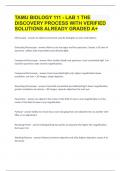
-
TAMU BIOLOGY 111 - LAB 1 THE DISCOVERY PROCESS WITH VERIFIED SOLUTIONS ALREADY GRADED A+ 2024 LATEST UPDATE
- Exam (elaborations) • 3 pages • 2023
- Available in package deal
-
- $15.49
- + learn more
Microscope An optical instrument used by biologists to view small objects Dissecting Microscope Allows us to see larger and live specimen; Creates a 3D view of specimen. Utilizes both transmitted and reflected light. Brainpower Read More Previous Play Next Rewind 10 seconds Move forward 10 seconds Unmute 0:05 / 0:15 Full screen Compound Microscope View smaller details and specimen. Uses transmitted light. Can examine specimen under several magnifications. Co...

How much did you already spend on Stuvia? Imagine there are plenty more of you out there paying for study notes, but this time YOU are the seller. Ka-ching! Discover all about earning on Stuvia


